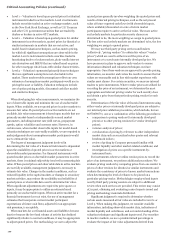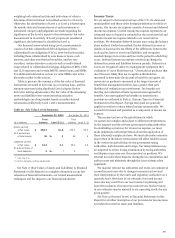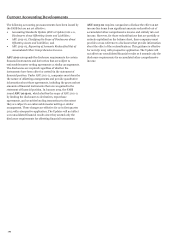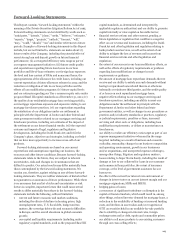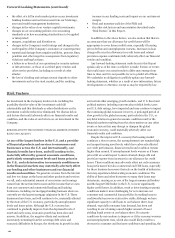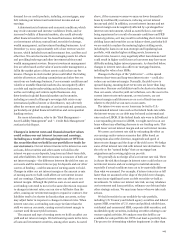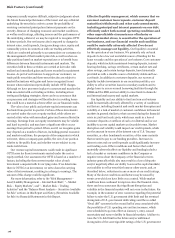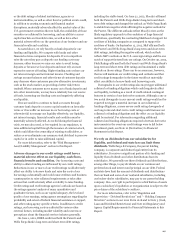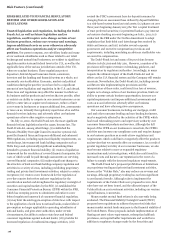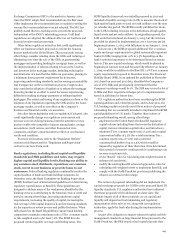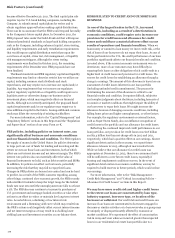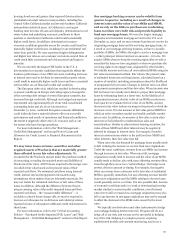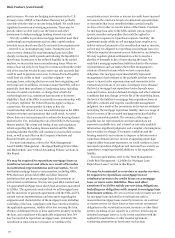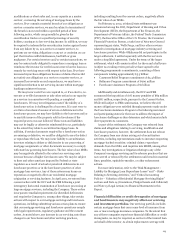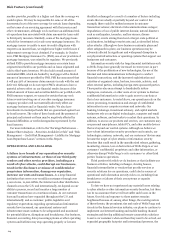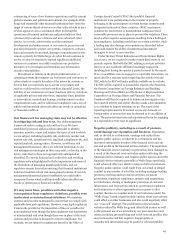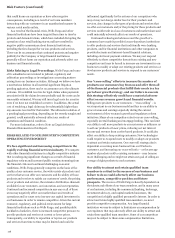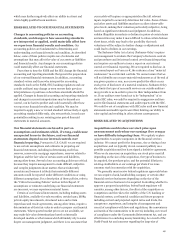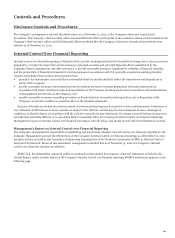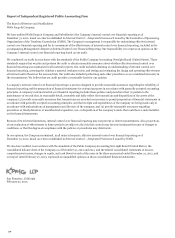Wells Fargo 2012 Annual Report Download - page 112
Download and view the complete annual report
Please find page 112 of the 2012 Wells Fargo annual report below. You can navigate through the pages in the report by either clicking on the pages listed below, or by using the keyword search tool below to find specific information within the annual report.Risk Factors (continued)
became effective December 30, 2011. The final capital plan rule
requires top-tier U.S. bank holding companies, including the
Company, to submit annual capital plans for review and to
obtain regulatory approval before making capital distributions.
There can be no assurance that the FRB would respond favorably
to the Company’s future capital plans. In December 2011, the
FRB proposed rules under the Dodd-Frank Act that will impose
enhanced prudential standards on large bank holding companies
such as the Company, including enhanced capital, stress testing,
and liquidity requirements and early remediation requirements
that would impose capital distribution restrictions upon the
occurrence of capital, stress test, risk management, or liquidity
risk management triggers. Although the stress testing
requirements were finalized in October 2012, the remaining
requirements of the December 2011 FRB proposals have not
been finalized.
The Basel standards and FRB regulatory capital and liquidity
requirements may limit or otherwise restrict how we utilize our
capital, including common stock dividends and stock
repurchases, and may require us to increase our capital and/or
liquidity. Any requirement that we increase our regulatory
capital, regulatory capital ratios or liquidity could require us to
liquidate assets or otherwise change our business and/or
investment plans, which may negatively affect our financial
results. Although not currently anticipated, the proposed Basel
capital requirements and/or our regulators may require us to
raise additional capital in the future. Issuing additional common
stock may dilute the ownership of existing stockholders.
For more information, refer to the “Capital Management” and
“Regulatory Reform” sections in this Report and the “Regulation
and Supervision” section of our 2012 Form 10-K.
FRB policies, including policies on interest rates, can
significantly affect business and economic conditions
and our financial results and condition. The FRB regulates
the supply of money in the United States. Its policies determine
in large part our cost of funds for lending and investing and the
return we earn on those loans and investments, both of which
affect our net interest income and net interest margin. The FRB’s
interest rate policies also can materially affect the value of
financial instruments we hold, such as debt securities and MSRs.
In addition, its policies can affect our borrowers, potentially
increasing the risk that they may fail to repay their loans.
Changes in FRB policies are beyond our control and can be hard
to predict. As a result of the FRB’s concerns regarding, among
other things, continued slow economic growth, the FRB recently
indicated that it intends to keep the target range for the federal
funds rate near zero until the unemployment rate falls to at least
6.5%. The FRB also may continue to increase its purchases of
U.S. government and mortgage-backed securities or take other
actions in an effort to reduce or maintain low long-term interest
rates. As noted above, a declining or low interest rate
environment and a flattening yield curve which may result from
the FRB’s actions could negatively affect our net interest income
and net interest margin as it may result in us holding lower
yielding loans and investment securities on our balance sheet.
RISKS RELATED TO CREDIT AND OUR MORTGAGE
BUSINESS
As one of the largest lenders in the U.S., increased
credit risk, including as a result of a deterioration in
economic conditions, could require us to increase our
provision for credit losses and allowance for credit
losses and could have a material adverse effect on our
results of operations and financial condition. When we
loan money or commit to loan money we incur credit risk, or the
risk of losses if our borrowers do not repay their loans. As one of
the largest lenders in the U.S., the credit performance of our loan
portfolios significantly affects our financial results and condition.
As noted above, if the current economic environment were to
deteriorate, more of our customers may have difficulty in
repaying their loans or other obligations which could result in a
higher level of credit losses and provision for credit losses. We
reserve for credit losses by establishing an allowance through a
charge to earnings. The amount of this allowance is based on our
assessment of credit losses inherent in our loan portfolio
(including unfunded credit commitments). The process for
determining the amount of the allowance is critical to our
financial results and condition. It requires difficult, subjective
and complex judgments about the future, including forecasts of
economic or market conditions that might impair the ability of
our borrowers to repay their loans. We might increase the
allowance because of changing economic conditions, including
falling home prices and higher unemployment, or other factors.
For example, the regulatory environment or external factors,
such as Super Storm Sandy, also can influence recognition of
credit losses in the portfolio and our allowance for credit losses.
Reflecting the continued improved credit performance in our
loan portfolios, our provision for credit losses was $1.8 billion
and $3.4 billion less than net charge-offs in 2012 and 2011,
respectively, which had a positive effect on our earnings. Absent
significant deterioration in the economy, we expect future
allowance releases in 2013, although at more modest levels.
While we believe that our allowance for credit losses was
appropriate at December 31, 2012, there is no assurance that it
will be sufficient to cover future credit losses, especially if
housing and employment conditions worsen. In the event of
significant deterioration in economic conditions, we may be
required to build reserves in future periods, which would reduce
our earnings.
For more information, refer to the “Risk Management –
Credit Risk Management” and “Critical Accounting Policies –
Allowance for Credit Losses” sections in this Report.
We may have more credit risk and higher credit losses
to the extent our loans are concentrated by loan type,
industry segment, borrower type, or location of the
borrower or collateral. Our credit risk and credit losses can
increase if our loans are concentrated to borrowers engaged in
the same or similar activities or to borrowers who as a group may
be uniquely or disproportionately affected by economic or
market conditions. We experienced the effect of concentration
risk in 2009 and 2010 when we incurred greater than expected
losses in our residential real estate loan portfolio due to a
110


